初中英语重点短语用法及其区别 (2)
英语初中常用易混淆单词词组的区别用法

中考初中英语常用易混淆单词词组的区别用法英语常用易混淆单词/词组的区别用法一、how much和how many的区别用法how much和how many的区别:how much用来询问事物的数量,后接不可数名词;how many用来询问事物的数量,后接可数名词复数。
how much和how many的区别1、所修饰词不同how much用来修饰不可数名词,表示数量,也可单独使用。
how many用来修饰可数名词的复数,它的句式是:How many+复数名词+一般疑问句+?例句:How much milk is there in the glass?玻璃杯里有多少牛奶?How many books are there on the desk?有多少本书在桌子上?2、用法不同How much 表示多少钱,用来问价格。
例句:How much is this dress?这个连衣裙多少钱?How many 表示多少,用来问数量。
例句:How many apples do you have?你有多少苹果?二、in和on的区别用法当我们表示某些东西被其他东西所包围时使用“in”这个词。
而“on”用于描述物体被放置在其他物体上方或外部的情况。
in可表时间,表地点,表手段、方法、材料。
on表示时间、地点、方位等。
in和on区别一、意思不同in:prep. 在 ... 里;在 ... 地方;在 ... 期间on:prep. 在 ... 之上二、用法不同in: in着重一段时间的过程,常用于重复动作或延续动作。
in表示从现在时间算起推移到将来的一段时间之后,一般与将来时态连用。
例句:He is a layman in economics.他对经济学一窍不通。
on:表示“在物体的表面上”,只能用on的表达方式有on the next morning,on the following。
例句:The spider is walking on the ceiling.蜘蛛在天花板上爬行。
初中英语语法大全[知识点总结(2)(可编辑修改word版)
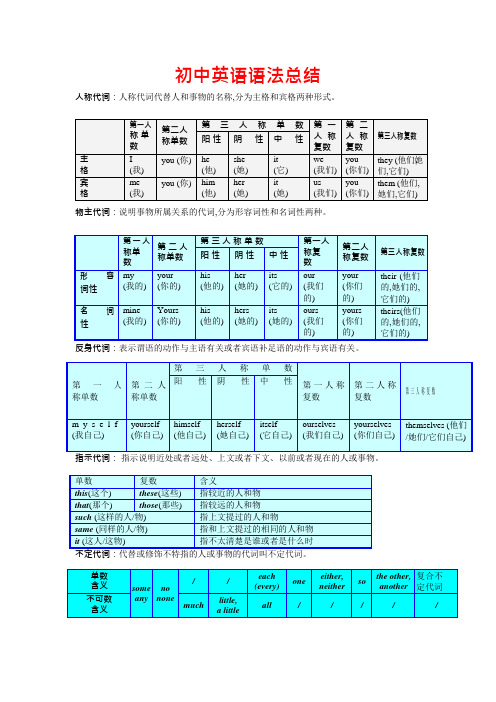
初中英语语法总结人称代词:人称代词代替人和事物的名称,分为主格和宾格两种形式。
物主代词:说明事物所属关系的代词,分为形容词性和名词性两种。
some 和any 的用法:some 一般用于肯定句中,意思是“几个”、“一些”、“某个”作定语时可修饰可数名词或不可数名词some 用于疑问句时,表示建议、请求或希望得到肯定回答。
any 一般用于疑问句或否定句中,意思是“任何一些”、“任何一个”,作定语时可修饰可数或不可数名词。
any 用于肯定句时,意思是“任何的”。
all 和both 的用法:all 指三者或三者以上的人或物,用来代替或修饰可数名词;也可用来代替或修饰不可数名词。
both 指两个人或物,用来代替或修饰可数名词。
all 和both 在句子中作主语、宾语、表语、定语等。
all 和both 既可以修饰名词(all/both+(the)+名词),也可以独立使用,采用“all/both + ofthe +名词(复数)”的形式,其中的of 可以省略。
every 和each 用法:every 是形容词,只能作定语修饰单数名词,意思是“每一个”,表示整体概念;each 是形容词、代词,可用作主语、宾语、定语等,意思是“每个”或者“各个”,表示单个概念;each 可以放在名词前,可以后跟of 短语,与动词同时出现时要放在“be 动词、助动词、情态动词”之后或者行为动词之前every 和each 都用作单数理解,但是下文中既可以用单数的代词(如he/him/his)也可以用复数的代词(如they/them/their)替代。
either 和neither 的用法:either 意思是“两个中间的任何一个”;neither 是either 的否定形式,意思是“两个都不”。
neither 和either 在句子中可作主语、宾语和定语等,都用作单数。
other、the other 和another 的用法:other 意思是“另一”、“另一些”,有复数形式。
初中英语中考常用词汇词组短语用法区分(共24组)
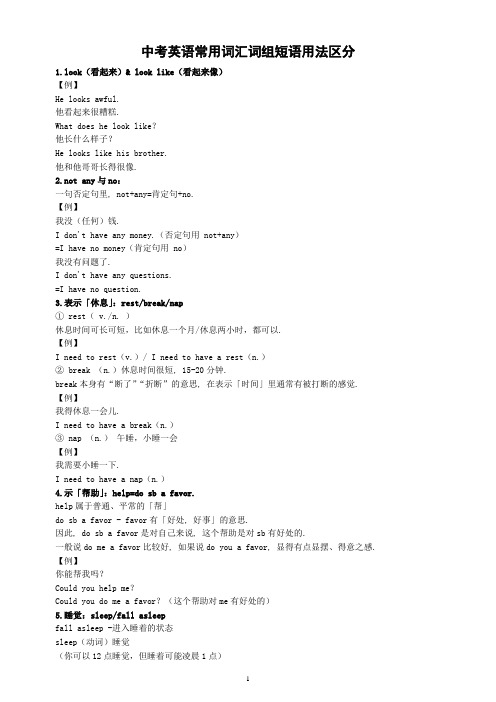
中考英语常用词汇词组短语用法区分1.look(看起来)& look like(看起来像)【例】He looks awful.他看起来很糟糕.What does he look like?他长什么样子?He looks like his brother.他和他哥哥长得很像.2.not any与no:一句否定句里, not+any=肯定句+no.【例】我没(任何)钱.I don't have any money.(否定句用 not+any)=I have no money(肯定句用 no)我没有问题了.I don't have any questions.=I have no question.3.表示「休息」:rest/break/nap① rest( v./n. )休息时间可长可短,比如休息一个月/休息两小时,都可以.【例】I need to rest(v.)/ I need to have a rest(n.)② break (n.)休息时间很短, 15-20分钟.break本身有“断了”“折断”的意思, 在表示「时间」里通常有被打断的感觉. 【例】我得休息一会儿.I need to have a break(n.)③ nap (n.)午睡,小睡一会【例】我需要小睡一下.I need to have a nap(n.)4.示「帮助」:help=do sb a favor.help属于普通、平常的「帮」do sb a favor - favor有「好处, 好事」的意思.因此, do sb a favor是对自己来说, 这个帮助是对sb有好处的.一般说do me a favor比较好, 如果说do you a favor, 显得有点显摆、得意之感. 【例】你能帮我吗?Could you help me?Could you do me a favor?(这个帮助对me有好处的)5.睡觉:sleep/fall asleepfall asleep -进入睡着的状态sleep(动词)睡觉(你可以12点睡觉,但睡着可能凌晨1点)【例】我昨晚12点就睡了, 但1点才睡着.I went to sleep at 12 last night, but I fell asleep at 1.6.in time及时/on time准时比如:约7点见面.in time及时, 指在7点之内就到了, 可能还不到7点就到了.on time准时/按时, on是在...上面, 如果正好在7点上, 等于正好7点准时到.7.征求... ask for....ask sb for permission向某某请求同意ask for sb's permission请求某某的同意2种都可以用8.洗澡:shower/bathtake a shower(淋浴 ,花洒的洗澡)have a bath(泡澡 ,带浴缸的)bath tub浴缸9.工作:job/workjob-工作的名词,找了一份/两份工作work-工作的内容【例】我找到了2份工作.I found two jobs.我的工作没做完.I didn't finish my work.10.想要/需要:want/needwant和need的用法相同, 后面都可以:+to do+sb to do+n.(名词)+to+be+形容词(a.)【例】我需要你的帮助.+n.(名词)I need/want your help.(help在这里是名词)我想要洗澡I need a shower.(+名词)I need to take a shower(+to do)我需要你帮我.+sb to doI need/want you to help me.(help在这里是动词)我想让你开心I want you to be happy.(+形容词)-happy是形容词,前面加be,to后面要加动词,be是系动词,也属于动词的一种综上,有动词+do没有动词:用名词/形容词/介词短语/副词/done,且这些词前面一定要+be动词11.表示「担心」:worried(a.)-状态worry(v.)-动作【例】我不想让你担心.I don't want you to be worried.-句中没有动词,worried是形容词, 前面要加be(只要没有动词,就要+be动词)我真的很担心你.I really worry about you.(worry-动词)12.想要/需要:need/have to口语中都可以表示“得.../不得不.../不用.../不需要.../不必...”我得把作业做了I need/have to finish my homework.(+to do)你得休息了.You need a rest.(+n.)You need/have to rest.(+to do)你不用/不必关心我.You don't have to care about me.13.want/be going to do① want想(要),表示意愿和欲望,都是脑子里的想法,实际上会不会去做未知② be going to do要,准备,打算,表示主语/说话人的计划,基本上要实施(实际生活中,要结合实际情景运用)14.最好...had better (not) do sth.【例】你最好去看医生.You had better go to see a doctor.(也可略写成 You’d better...)15.有...要....have sth to do【例】我有很多作业要做.I have a lot of homework to do.我没钱看电影.I don't have money to watch movie.16.already(已经)&yet(还)① already&yet都是副词(adv.), 在现在完成时中, 可加可不加.-如果加上, 有点儿”锦上添花“的意思.-如果不加, 对「现在完成时强调动作已完成」也不影响.「现在完成时」回顾 :【笔记】0基础入门英语语法 | 时态:现在完成时&一般过去时, 怎么区分?【例】他已经写完作业了.He has finished homework.He has finished homework already.(两句话意思相同)② already用于肯定句, yet多用于否定句/疑问句.【例】他已经写完作业了.He has finished homework already.他还没写完作业.He hasn't finished homework yet.③如果不使用现在完成时(不强调动作已完成), 句中用already&yet, 则表示已经处于某种状态.【例】我已经在路上了.I'm already on the way.他还不是个老师.He is not a teacher yet.(事情还没发生)综上:-句中有动作, 且强调动作已完成, 用现在完成时, 表示「已经/还」, already/yet可加可不加.-句中没有动作, 不强调动作完成, 不用现在完成时, 只强调已经处于某种状态, 要加already/yet.17.表示「还...」:yet&still① yet用于否定句/疑问句, 通常翻译为:还没...② still用于肯定句, 通常翻译为:仍然.../还...【例】他们仍然(还)记得那天.They still remember that day.我还没回家.I'm not home yet.18.表示「再...」again & any more① again用于肯定句/否定句② any more用于否定句/疑问句, 通常翻译为:再也不.../不再....③ again表示「再一次...」,any more既可以表示「程度」,又可以表示「次数」【例】我再也不吃糖了.I will not eat candy again/any more.我再也不会输了.I won't lose again.(下一次不会再输)I won't lose any more.(不会输)非谓语动词做名词(宾语)I(主) like(谓) making friends(宾).I finish doing my homework.(关于「非谓语动词」, 咱后边还会专门讲, 敬请关注~)19.表示「擅长...」be good at doing sth- good是形容词, be good是「系表」结构, 如果前面加上主语, 则结构完整, 后面可以加adv./介词短语.- at是介词, 后面不可能再用动词, 所以doing是把动词加上ing变成名词, 在这里与前面的介词共同构成介词短语.- 用法延伸:be good表示「XXX很好」, good也可以替换成其它表示”好“的形容词:great/fantastic...↓be good/great/fantastic...+at doing sth.20.使动词用法&make两者都有“让某人....”的意思, 区别在于:① make后面只能加使动词的形容词(a.)形式, 构成「主谓宾+宾补」的结构②使动词本身就有“让某人....”的意思综上:make sb +a.(主谓宾宾补)让...disappoint(使动词) sb让...失望=make sb disappointed(a.)=let sb down【例】我不想让你失望.I don't want to disappoint you.I don't want to make you disaapointed.I don't want to let you down.「使动词」相关知识点回顾 :【笔记】英语语法入门到精通(19)| 动词之:使动词(用法&归纳)21.表示「选择」:choice (n.), 复数形式:choiceschoose (v.)【例】菜单上有很多选择, 但我的选择是汉堡 .The menu had a lot of options, but my choice was the burger.我必须在今晚去健身房还是去看电影之间做选择.I have to choose between going to the gym or watching a movie tonight.22.表示「听到/听说」hear(vt)听到, 直接加人/物,都是可以发出声音的hear(vi) +介词of/about-听说【例】我能听到窗外的鸟叫.I can hear(vt.) the birds chirping outside my window.-hear后面直接跟鸟bird, 是可以发声的.我以前从未听说过那个餐厅.I've never heard of that restaurant before.你听说过市中心刚刚开业的新店吗?Have you heard about the new store that just opened downtown?-hear是不及物动词(vi),后面必须加介词, 表示“听说...”23.pick sb up捡起来, 接某人【例】我的朋友下班后要来接我.My friend is going to pick me up after work.24.表示「同意」① agree to 暗示了决定做某事的意愿是由别人提出或请求的, 有被迫同意的意味② agree with 同意某人的观点,它意味着一个人的观点与另一个人的观点是一致的③ agree on 意为与别人达成协议或共同决定。
初中英语个重点英语短语分类许多接可数名词复数谓语动词用复数跟一样

初中英语个重点英语短语分类许多接可数名词复数谓语动词用复数跟一样
以下是初中英语中一些重点英语短语的分类,这些短语通常接可数名词复数,谓语动词用复数形式,具体如下:
1. 表示一类人或事物的短语:the + 姓氏复数,表示“某某一家人”或“某某夫妇”;a group of + 可数名词复数,表示“一群/组......”。
2. 表示数量的短语:a number of + 可数名词复数,表示“许多/大量......”;several + 可数名词复数,表示“几个......”;a few + 可数名词复数,表示“一些......”;a lot
of/lots of + 可数名词复数/不可数名词,表示“许多/大量......”。
3. 表示职业、身份或状态的短语:复数名词 + in/at/on + 地点,表示“某地的......”;复数名词 + of + 名词,表示“......的......”。
4. 其他常用短语:all kinds of + 可数名词复数,表示“各种各样的......”;different kinds of + 可数名词复数,表示“不同种类的......”。
需要注意的是,这些短语中的谓语动词通常用复数形式,因为它们接的是可数名词复数。
但是,在某些情况下,根据上下文和具体语境,
谓语动词也可能用单数形式。
因此,在使用这些短语时,需要根据具体情况来确定谓语动词的单复数形式。
初中英语重点短语辨析

初中英语重点短语辨析1. be made of / be made fromⅠ. be made of “由……制成/造”成品看得出原料。
如:The desk is made of wood. 这张桌子是木头制成的。
Ⅱ. be made from “由……制造/成”成品看不出原料。
如;Paper is made from rags.纸是由破布做的。
(已看不出原料)2. be pleased with/ at/ toⅠ. be pleased with “对……人/物,感到满意”介词with后接人或物。
如:① Both Mark and her mother were pleased with the girl. 马克和他妈妈都有喜欢这个女孩。
② I wasn’t very pleased with / at my exam results. 我对自己的考试成绩不太满意。
Ⅱ. be pleased at “对……某事/物,感到满意”。
介词at 常与事物搭配使用。
He was very pleased at the news.他对这个消息感到很满意。
Ⅲ. be pleased to “乐意……;因……而高兴”。
to 不是介词,而是小品词。
后接动词原形。
如:① I shall be pleased to go. 我将乐意去。
② We are quite pleased to be working in this country. 能在这个国家工作,我们是十分高兴的。
3. be sure of/ be sure to do/ be sure thatⅠ.be sure of “确信对……有把握”后接名词、代词或动词-ing 形式,表对客观事物有肯定的认识和判断,主语必须是人。
如:① As David joined our team, we are sure of winning the game this time.由于David参加了我们的球队,我们这次有把握取胜。
初中英语动词及动词短语考点
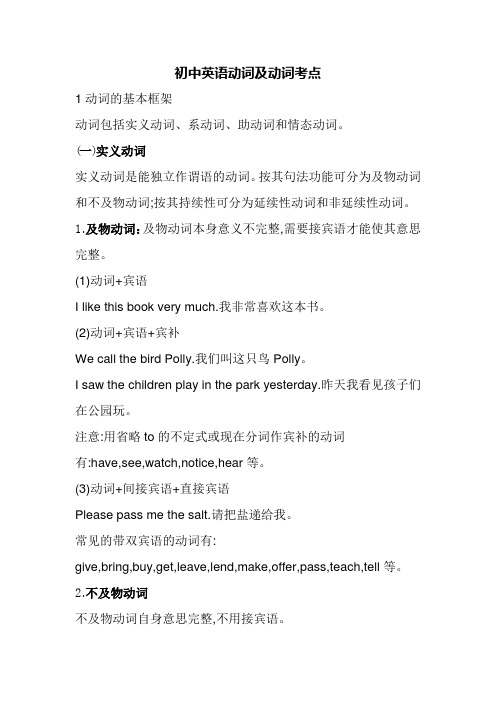
初中英语动词及动词考点1动词的基本框架动词包括实义动词、系动词、助动词和情态动词。
(一)实义动词实义动词是能独立作谓语的动词。
按其句法功能可分为及物动词和不及物动词;按其持续性可分为延续性动词和非延续性动词。
1.及物动词:及物动词本身意义不完整,需要接宾语才能使其意思完整。
(1)动词+宾语I like this book very much.我非常喜欢这本书。
(2)动词+宾语+宾补We call the bird Polly.我们叫这只鸟Polly。
I saw the children play in the park yesterday.昨天我看见孩子们在公园玩。
注意:用省略to的不定式或现在分词作宾补的动词有:have,see,watch,notice,hear等。
(3)动词+间接宾语+直接宾语Please pass me the salt.请把盐递给我。
常见的带双宾语的动词有:give,bring,buy,get,leave,lend,make,offer,pass,teach,tell等。
2.不及物动词不及物动词自身意思完整,不用接宾语。
Horses run fast.马跑得快。
(1)有些动词既可作及物动词又可作不及物动词。
We study English.我们学习英语。
(及物动词)We study hard.我们努力学习。
(不及物动词)(2)有些不及物动词与一些别的词搭配在一起构成动词短语,它的作用相当于一个及物动词。
①动词+介词Listen to the teacher carefully.仔细听老师讲。
此类动词短语后面的宾语无论是名词还是代词,都只能放在介词后面,不能放在动词和介词之间。
②动词+副词+介词Let’s go on with our work!让我们继续我们的工作吧!He gets along well with his classmates.他与他的同学们相处得很好。
八年级英语下册知识讲义-(Unit3 Lesson 9 Thanksgiving)-北师大版

学习目标1. 掌握重点短语的用法。
2. 辨析agree with,agree on,agree to。
重点:go wrong, be proud of, for a good price, agree with, after all, spend... with。
难点:agree的有关短语。
知识梳理【短语学习】1. go wrong 失败,弄不好,不顺利go wrong 的英语解释be unsuccessful,其近义词为:fail。
Everything went wrong in those days. 当时,事事不顺。
If something should go wrong, the signal lamp would light up. 万一发生什么事故,信号灯就会亮起来。
翻译句子:电梯也可能会出错,让你待在里面出不来。
答案:The elevator may also go wrong and keep you inside.2. be proud of 因……而骄傲be proud of 因……而自豪。
其中proud 为形容词,“自豪的,骄傲的”。
I’m proud of my country. 我为我的国家而骄傲。
take pride in 因……而自豪。
其中pride为名词。
We all take pride in your success. 我们都为你的成功而感动自豪。
—Li Na won the tennis championship in the French Open on June 4, 2011.—We ___________ her. She is the first Asian professional tennis player to win it.A. take pride ofB. be proud ofC. are proud inD. take pride in答案:D思路分析:句意:“李娜在2011年6月4号的法国网球公开赛上赢得了冠军。
初中英语必备(背)短语,句型
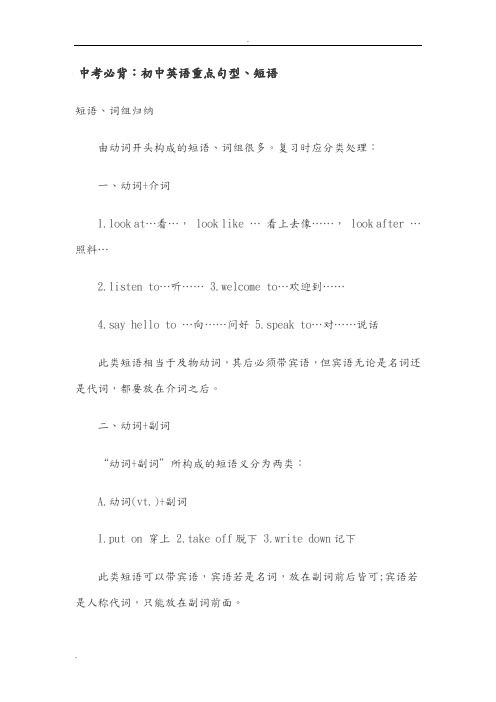
中考必背:初中英语重点句型、短语短语、词组归纳由动词开头构成的短语、词组很多。
复习时应分类处理:一、动词+介词1.look at…看…, look like …看上去像……, look after …照料…2.listen to…听……3.welcome to…欢迎到……4.say hello to …向……问好5.speak to…对……说话此类短语相当于及物动词,其后必须带宾语,但宾语无论是名词还是代词,都要放在介词之后。
二、动词+副词“动词+副词”所构成的短语义分为两类:A.动词(vt.)+副词1.put on 穿上2.take off脱下3.write down记下此类短语可以带宾语,宾语若是名词,放在副词前后皆可;宾语若是人称代词,只能放在副词前面。
B.动词(vi)+副词。
e on赶快2.get up起床3.go home回家e in进来5.sit down坐下6.stand up起立此类短语属于不及物动词,不可以带宾语。
三、其它类动词词组1.close the door2.1ook the same3.go to work/class4.be ill5.have a look/seat6.have supper7.1ook young8.go shopping9.watch TV/games 10. play games[介词短语聚焦]“介词+名词/代词”所构成的短语称为介词短语。
现将Unitsl-16常用的介词短语按用法进行归类。
1.in+语言/颜色/衣帽等,表示使用某种语言或穿着……。
2.in + Row/ Team/ Class/ Grade等,表示“在……排/队/班级/年级”等。
3.in the morning/ afternoon/ evening/ 表示“在上午/下午/傍晚”等一段时间。
4.in the desk/ pencil-box/bedroom 等表示“在书桌/铅笔盒/卧室里”。
初中英语重要短语用法及区别

初中英语重要短语用法及区别初中英语重要短语用法及区别我们在记忆单词的时候,面对易混淆的词语要注意分清。
下面是店铺整理的初中英语重要短语用法及区别,欢迎阅读!英语重要短语的用法及区别:find , look for,find out二者都有“寻找”的意思。
find是look for的结果。
What are you looking for ? 你在找什么?look for是find之前的寻找过程。
Have you found your pen ? 你找到你的钢笔了吗?Find out指经过一番努力最终找到。
I found out she was wrong.我发现她错了。
英语重要短语的用法及区别:whether,if这两个连词都作“是否”解,引导宾语从句时,两者通常可以互换。
但在下列几种情况下,不可用if 代替whether。
1)当whether 与or not连成词组时。
I don't know whether or not they will come for our help.我不知道他们是否来帮助我们。
2)whether 用在不定式前面时。
She hasn't decided whether to go or not.她还没有决定去还是不去。
3)whether引导的从句放在句首时。
Whether this is true or not,I can't say.这是不是真的,我不说(或我说不准)英语重要短语的用法及区别:date , daydate指"日期"。
What's the date today ? 今天几号?day指"星期几",指二十四小时的一整天;也单指白天;也指重要的日子.What day is today ? 今天星期几?There are seven days in a week . 一周有七天。
National Day 国庆节英语重要短语的用法及区别:join , take part in, join in二者都有“参加”的意思。
冀教版英语八年级上册知识讲义 重点短语(Unit 2 My Favourite School Subject Lesson10-Lesson12)
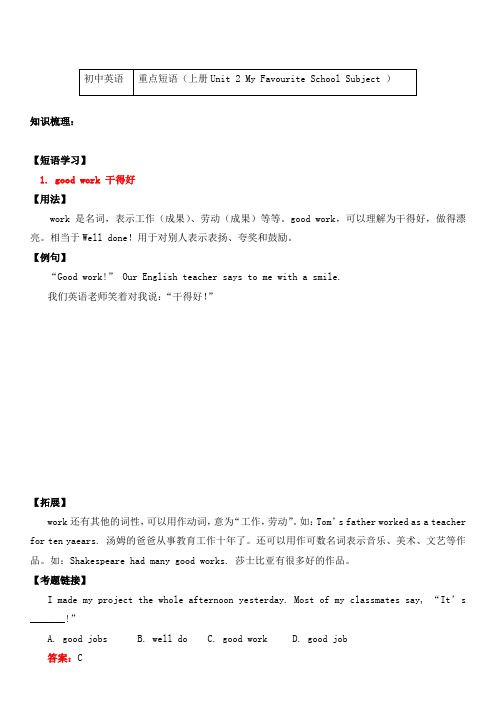
知识梳理:【短语学习】1. good work 干得好【用法】work是名词,表示工作(成果)、劳动(成果)等等。
good work,可以理解为干得好,做得漂亮。
相当于Well done!用于对别人表示表扬、夸奖和鼓励。
【例句】“Good work!” Our English teacher says to me with a smile.我们英语老师笑着对我说:“干得好!”【拓展】work还有其他的词性,可以用作动词,意为“工作,劳动”。
如:Tom’s father worked as a teacher for ten yaears. 汤姆的爸爸从事教育工作十年了。
还可以用作可数名词表示音乐、美术、文艺等作品。
如:Shakespeare had many good works. 莎士比亚有很多好的作品。
【考题链接】I made my project the whole afternoon yesterday. Most of my classmates say, “It’s _______!”A. good jobsB. well doC. good workD. good job答案:C思路分析:good work表示“优质的工作”“良好的工作”。
2. Mother’s Day 母亲节【用法】专有名词,“母亲节”两个单词第一个字母都需要大写,mother用单数形式,并且要用名词所有格’s。
【例句】I bought a nice present for my mother on Mother’s Day.【拓展】中国传统节日:春节the Spring Festival 元宵节(灯节)the Lantern Festival 清明节Tomb-sweeping Day 端午节the Dragon-Boat Festival 中秋节the Mid-Autumn Festival西方传统节日:愚人节April Fools’ Day 复活节Easter Day 万圣节Halloween Day 感恩节Thanksgiving Day 圣诞节Christmas Day【考题链接】The third Sunday in June is _______________.A. Father’s DayB. Mother’s DayC. Teachers’ DayD. Children’s Day答案:A思路分析:考查专有名词,每年六月的第三个星期日是父亲节。
中考英语—重点单词用法
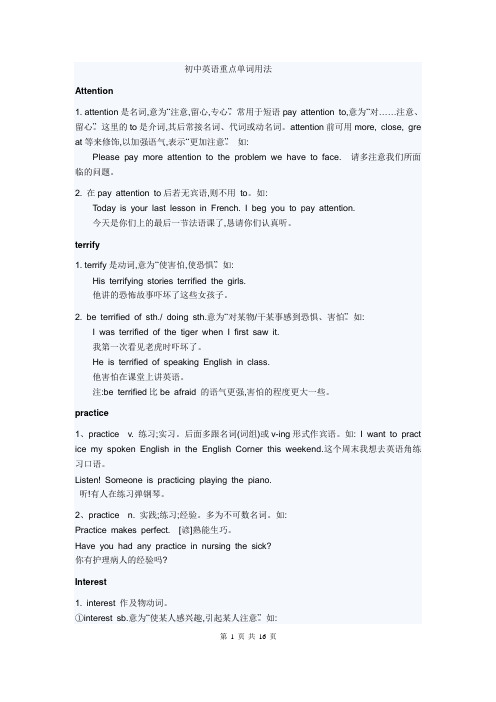
初中英语重点单词用法Attention1. attention是名词,意为“注意,留心,专心”。
常用于短语pay attention to,意为“对……注意、留心”。
这里的to是介词,其后常接名词、代词或动名词。
attention前可用more, close, gre at等来修饰,以加强语气,表示“更加注意”。
如:Please pay more attention to the problem we have to face. 请多注意我们所面临的问题。
2. 在pay attention to后若无宾语,则不用to。
如:T oday is your last lesson in French. I beg you to pay attention.今天是你们上的最后一节法语课了,恳请你们认真听。
terrify1. terrify是动词,意为“使害怕,使恐惧”。
如:His terrifying stories terrified the girls.他讲的恐怖故事吓坏了这些女孩子。
2. be terrified of sth./ doing sth.意为“对某物/干某事感到恐惧、害怕”。
如:I was terrified of the tiger when I first saw it.我第一次看见老虎时吓坏了。
He is terrified of speaking English in class.他害怕在课堂上讲英语。
注:be terrified比be afraid 的语气更强,害怕的程度更大一些。
practice1、practice v. 练习;实习。
后面多跟名词(词组)或v-ing形式作宾语。
如: I want to pract ice my spoken English in the English Corner this weekend.这个周末我想去英语角练习口语。
Listen! Someone is practicing playing the piano.听!有人在练习弹钢琴。
译林版牛津初中英语中考英语常考易混易错重要知识点、语法讲解整理

中考英语常考易混易错重要知识点、语法讲解整理Mr Sun一、介词in/on/at区别1、在泛指在早上、在下午、在晚上、在夜间,用in如:in the morning在早上in the afternoon在下午in the evening在晚上in the night二at night在夜间2、在morning/afternoon/evening/night有定语修饰的时候,要用介词on如:on a cold morning(cold是前置定语)在一个寒冷的早晨On the morning of May1st(of May1"是后置定语)在五月一日的上午3、在某年、某月、某年某月用in,在具体的某一天、在星期儿用。
n,在具体的某一时刻、在中午用at如:in2018在2018年,in January在1月,in February,2018在2018年2月,on the first在1 号,on October1st,2018在2018年10月1号,on/at weekends=on/at the weekend在周末,on Monday在星期一,at six在六点,on weekdays在平日,at noon在中午二、used to do sth.用法1、used to do sth.肯定句式used to do sth.“过去常常做某事/以前经常做某事/曾经”,暗示现在不这样做了。
to为不定式符号,后接动词原形。
如:I used to be a worker,but now I set up a company and become a businessman.It曾经是一名工人,但是现在我成立了公司,成为了一名商人。
(现在不是工人了)The boy used to play soccer after school.这个男孩过去常常放学后踢足球。
(现在不踢了)2、used to do sth.否定句式iin+usedift/used not/didn't use+to do如:He didn't use to study luird=He usedn't to study hard.=He used not to study hard.他过去常常不努力学习。
初中英语中有很多常用短语意义相近却不相同
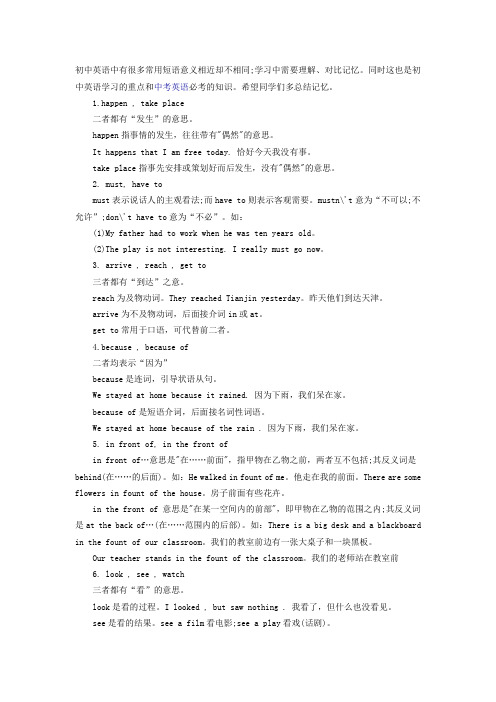
初中英语中有很多常用短语意义相近却不相同;学习中需要理解、对比记忆。
同时这也是初中英语学习的重点和中考英语必考的知识。
希望同学们多总结记忆。
1.happen , take place二者都有“发生”的意思。
happen指事情的发生,往往带有"偶然"的意思。
It happens that I am free today. 恰好今天我没有事。
take place指事先安排或策划好而后发生,没有"偶然"的意思。
2. must, have tomust表示说话人的主观看法;而have to则表示客观需要。
mustn\'t意为“不可以;不允许”;don\'t have to意为“不必”。
如:(1)My father had to work when he was ten years old。
(2)The play is not interesting. I really must go now。
3. arrive , reach , get to三者都有“到达”之意。
reach为及物动词。
They reached Tianjin yesterday。
昨天他们到达天津。
arrive为不及物动词,后面接介词in或at。
get to常用于口语,可代替前二者。
4.because , because of二者均表示“因为”because是连词,引导状语从句。
We stayed at home because it rained. 因为下雨,我们呆在家。
because of是短语介词,后面接名词性词语。
We stayed at home because of the rain . 因为下雨,我们呆在家。
5. in front of, in the front ofin front of…意思是"在……前面",指甲物在乙物之前,两者互不包括;其反义词是behind(在……的后面)。
初中英语常见常考易混短语例解
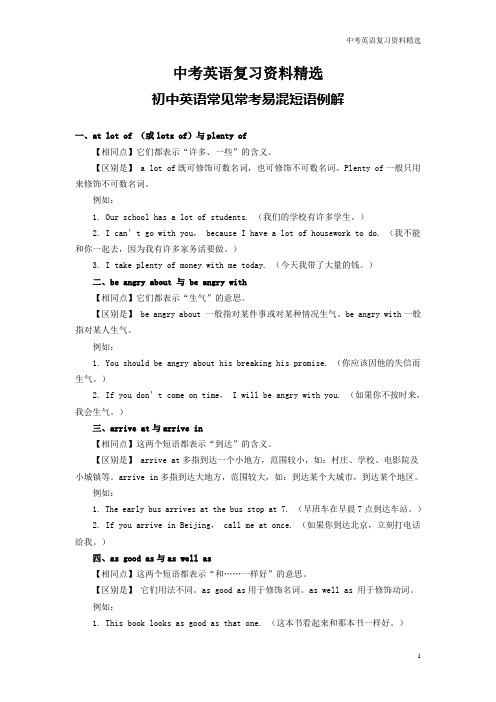
中考英语复习资料精选初中英语常见常考易混短语例解一、at lot of (或lots of)与plenty of【相同点】它们都表示“许多、一些”的含义。
【区别是】 a lot of既可修饰可数名词,也可修饰不可数名词。
Plenty of一般只用来修饰不可数名词。
例如:1. Our school has a lot of students. (我们的学校有许多学生。
)2. I can’t go with you, because I have a lot of housework to do. (我不能和你一起去,因为我有许多家务活要做。
)3. I take plenty of money with me today. (今天我带了大量的钱。
)二、be angry about 与 be angry with【相同点】它们都表示“生气”的意思。
【区别是】 be angry about 一般指对某件事或对某种情况生气。
be angry with一般指对某人生气。
例如:1. You should be angry about his breaking his promise. (你应该因他的失信而生气。
)2. If you don’t come on time, I will be angry with you. (如果你不按时来,我会生气。
)三、arrive at与arrive in【相同点】这两个短语都表示“到达”的含义。
【区别是】 arrive at多指到达一个小地方,范围较小,如:村庄、学校、电影院及小城镇等。
arrive in多指到达大地方,范围较大,如:到达某个大城市,到达某个地区。
例如:1. The early bus arrives at the bus stop at 7. (早班车在早晨7点到达车站。
)2. If you arrive in Beijing, call me at once. (如果你到达北京,立刻打电话给我。
有关初中英语重要短语用法及区别好
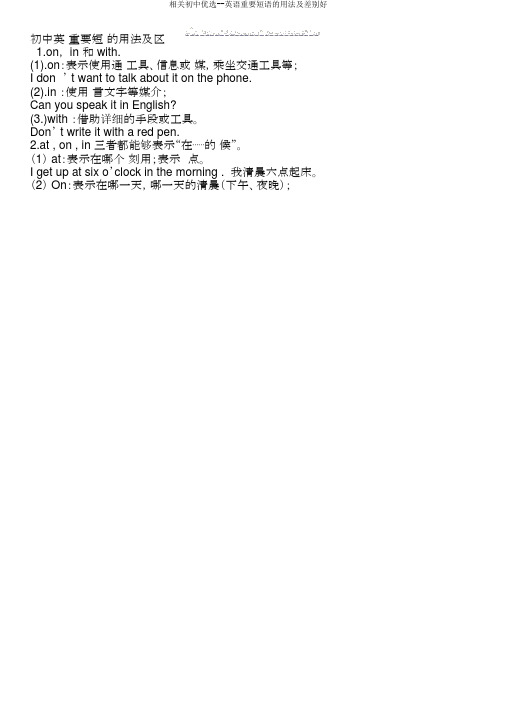
初中英重要短的用法及区1.on, in 和 with.(1).on:表示使用通工具、信息或媒,乘坐交通工具等;I don ’ t want to talk about it on the phone.(2).in :使用言文字等媒介;Can you speak it in English?(3.)with :借助详细的手段或工具。
Don’ t write it with a red pen.2.at , on , in 三者都能够表示“在⋯⋯的候”。
(1) at:表示在哪个刻用;表示点。
I get up at six o’clock in the morning . 我清晨六点起床。
(2) On:表示在哪一天,哪一天的清晨(下午、夜晚);on Wednesday , on Sunday morning , on May I , on a cold morning in 1936 (3) in:表示在哪一年(季、月),在上午,下午等。
in September , in the morning , in the afternoon3. spend, pay,cost, take(1)Sb. Spend⋯on sth.某人花了⋯(、金)在某事上。
I spend ten yuan on the book..(2)spend(in) doing sth. 某人花了⋯(、金)做某事。
She spent two hours in drawing the house.(3)Sb. pay ⋯ for⋯sth.某人某物花了⋯。
I paid 50 yuan for the clothes.(4)Sth. cost sb. ⋯某物花了某人⋯。
It cost us five dollars.(5)It takes/took sb. ⋯ to do sth.花了某人⋯(、金)做某事。
It takes us ten minutes to brush my teeth every day.4.too much, too many, much tootoo much + 不行数名too many + 可数名much too + 形容、副、(1) There is too much milk in the basket.(2)She ate too many biscuits yesterday morning.(3)He runs much too quickly.(4)The chair is much too expensive.5.not⋯until &untilnot ⋯ until直到⋯才⋯(主句是短性)(1)He didn’ t go to beduntil his mother came back..until向来到⋯(主句中使用延性)(2)I study hard until it is midnight every day.6.few, a few; little , a little.固然都表示“少” ,但·f ew, a few 是可数的 , little, a little 是不行数的。
初中英语人教版七年级上册重点短语句型汇总(Unit1-4)

七年级英语上册重点短语句型汇总U101词组或短语good morning 早上好good afternoon 下午好good evening 晚上好telephone/phone number 电话号码first name 名字last name 姓middle school 中学;初中02be动词的一般现在时be动词有am,is,are,是“……是……”的意思。
那什么时候用am,什么时候用is,什么时候用are呢?对此,我们总结出了一个小口诀,一起来看看吧。
我用am,你用are,is跟着他她它。
单数名词用is,复数一律要用are。
这个口诀大家可以多读几遍,牢牢记住哦。
03be动词的一般现在形容词性物主代词放在名词前,表示所属关系,意为“……的”。
常见的形容词性物主代词及用法见下表:注意:形容词性物主代词置于名词前,作定语。
如:我的钢笔 my pen你的杯子 your cup他的直尺 his ruler她的娃娃 her doll它的名字 its name我们的学校 our school你们的教室 your classroom他们的老师 their teacher04用what-问句询问电话号码Q: What’s (What is) your telephone number?你的电话号码是多少?A: My (telephone) number is 12345.我的电话是12345.U201重点单词或短语1.Have a good day!(表示祝愿)过得愉快!2.a lot of 许多3.family 家;家庭4.here (用以介绍某人或某物)这就是;在这里5.photo 照片6.who 谁,什么人02who引导的特殊疑问句1.用法Who意为“谁”,特殊疑问句不用yes或no回答。
2.句型Who + be动词 + 主语?如:— Who is she?—She is my sister.U301重点词组或短语1.ask 请求;要求;询问2.excuse me 劳驾;请原谅3.thank you for... 为……而感谢你(们)puter 电脑5.help 帮助;援助6.ID card 学生卡;身份证puter game 电脑游戏8.in the school library 在学校图书馆里9.ask...for... 请求;恳求(给予)10.a set of 一套;一副;一组11.e-mail sb.at + 邮箱地址给某人发电子邮件到……12.call sb.at + 电话号码拨打电话……找某人13.Lost and Found 失物招领处02含有be动词的一般疑问句定义一般疑问句是用来询问某事或某种情况是否属实,并需要对方用yes或no作出回答的问句。
初中英语因定短语知识点:重点短语句型详解

初中英语因定短语知识点:重点短语句型详解1. She used to be a Chinese teacher. 她过去是一位汉语老师。
[用法] used to + 动词原形,表示过去经常性的动作或存在的状态,含有现在不再如此之意。
[搭配] used to do的否定式可以是usednt to do或didnt use to do.[比较] used to do sth. 过去常做某事;be/ get used to doing sth. 习惯于做某事;be used to do sth. 被用来做某事。
2.return it sooner or later.迟早要将它归还。
[用法] l)sooner or later意为迟早、早晚。
2)return此处用作及物动词,意为归还,相当于give back.[拓展]return还可用作不及物动词,意为返回,相当于go back或come back。
3.No matter what the weather is like无论天气[用法]no matter what 相当于whatever,其意为无论什么,引导状语从句。
[拓展]类似no matter what的表达方式还有:no matter when无论什么时候nbsp; nbsp;nbsp;no matter where无论什么地方no matter who无论谁no matter how 无论怎么样4. A young man practised speaking English with Mr. Green.一位年经人与格林先生练习讲英语。
[用法]practise doing sth. 表示实践、练习(做)某事。
[拓展]practice名词,实践、实施、练习;put a plan into practice实行某计划。
5. He encouraged everyone to take part in protecting our lakes, rivers, seas and oceans.他鼓励大家参加保护我们的湖泊、河流和海洋的活动。
新人教版初三第一学期英语unit2重点短语
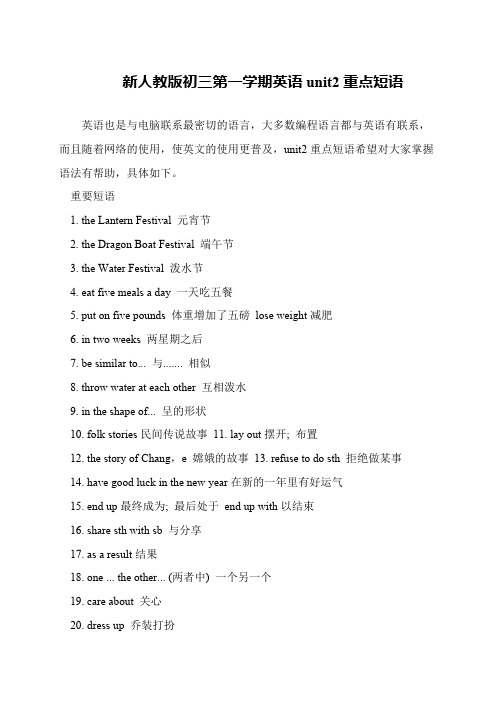
新人教版初三第一学期英语unit2重点短语
英语也是与电脑联系最密切的语言,大多数编程语言都与英语有联系,而且随着网络的使用,使英文的使用更普及,unit2重点短语希望对大家掌握语法有帮助,具体如下。
重要短语
1. the Lantern Festival 元宵节
2. the Dragon Boat Festival 端午节
3. the Water Festival 泼水节
4. eat five meals a day 一天吃五餐
5. put on five pounds 体重增加了五磅lose weight减肥
6. in two weeks 两星期之后
7. be similar to... 与....... 相似
8. throw water at each other 互相泼水
9. in the shape of... 呈的形状
10. folk stories民间传说故事11. lay out摆开; 布置
12. the story of Chang,e 嫦娥的故事13. refuse to do sth 拒绝做某事
14. have good luck in the new year在新的一年里有好运气
15. end up最终成为; 最后处于end up with以结束
16. share sth with sb 与分享
17. as a result结果
18. one ... the other... (两者中) 一个另一个
19. care about 关心
20. dress up 乔装打扮。
初中英语备考-常用易混易错的单词和词组的区别用法、易错句型及短语梳理

初中英语备考-常用易混易错的单词/词组的区别用法、易错句型及短语梳理一、英语常用易混淆单词/词组的区别用法if和whether的区别用法if和whether的区别:if和whether在宾语从句中,都表“是否”,可换用,if更口语化,whether正式些。
当有or not时,一般用whether,而不用if。
1.or not放在whether之后时,只能用whether不用if。
例句:I don’t know whether or not he will come.我不知道他是不是回来。
注:如果or not放在whether所引导的从句句尾,则可以用if来替换。
I don’t know whether/if he will come or not.我不知道他是不是回来。
2.在强调任意选择时,用whether…or,此时不用if替换whether。
例句:He asked me whether I wanted to go there by train or by bus.他问我是想乘火车还是坐公共汽车去那里。
注:whether和or一起还有“不管”之意,引导让步状语从句。
Whether he drives or takes the train, he will be here on time.不管开车来还是乘火车来,他都会准时到。
3.虽引导宾语从句,但为了强调宾语部分,也可把从句放在句首,此时只用whether不用if。
例句:Whether he will come I am not sure.他是不是来我拿不准。
4.从句作介词宾语时只用whether不用if。
例句:It depends on whether it will be fine.那得看是不是晴天。
5.作discuss等动词的宾语时,用whether不用if。
例句:We discussed whether we should close the shop.我们讨论是不是该关掉商店。
- 1、下载文档前请自行甄别文档内容的完整性,平台不提供额外的编辑、内容补充、找答案等附加服务。
- 2、"仅部分预览"的文档,不可在线预览部分如存在完整性等问题,可反馈申请退款(可完整预览的文档不适用该条件!)。
- 3、如文档侵犯您的权益,请联系客服反馈,我们会尽快为您处理(人工客服工作时间:9:00-18:30)。
初中英语重点短语用法及其区别初中英语重点短语用法及其区别1. also, either , too , as wellalso 用于肯定句. You study English and I also study it.你学英语.我也学.either 用于否定句,并放在句尾;You don’t study English and I don't study it either.你不学英语,我也不学.too / as well 用于肯定句,放在句尾,多用于口语。
例如:You are a student and I am a student, too. 你是学生,我也是。
You know the way and I know it as well. 你知道路,我也知道。
2. among , betweenbetween表示“两者”之间Do you know the difference between the two words? 你知道这两个词有什么不同吗?among表示“三者或三者以上之间。
He is the most energetic boy among them. 他是他们中间精力最饱满的孩子。
3. as , when , whilewhen:可与一个点的时间或表示一段的时间连用,从句动词可以是短暂性或延续性动词。
从句的动作和主句的动作可以同时,也同先于主句的动作;When the teacher came in, the students stood up . 当老师进来时,学生们起立。
while:只指一段时间,不能指一点时间。
因此while从句中的谓语动词必须是延续性动词。
表示一段较长的时间或一个过程,主句和从句的动作同时发生。
Don’t talk whil e you are eating. 吃饭时你不要说话。
as:主句和从句的动作同时发生,有时可译作“一边……,一边”。
4.besides , except , besides的意思是“除…之外,还有…”是肯定的;包括, besides 后面的宾语在内,含有“加上”的意思。
I have three other pens besides this. 除了这支笔外,我还有另外三支笔。
except(but)的意思是“除……之外,没有…”是否定的;不包括except 后的宾语在内,含有“减去”的意思。
Everyone get good marks except Mary5.except for , but“除……之外”but 用于“除了”之意时,只能用于no one, nobody, nothing, all, everyone, everything 等词之后。
Everybody is here except(but)Mary . 除了Mary之外,大家都来了。
except for的用法是在说明基本情况后,而在细节上加以纠正。
except for 有时可以与except 互换,表示“除了……之外”,但位于句首时,不可以和except 互换。
例如:Your composition is good except for some spelling mistakes .除了有几个拼写错误之外,你的作文很好。
(了解)6. bring, take , fetch , get , carry这几个动词都有“携带”、“运送”的意思。
但它们表示的动作方向不同。
bring是“带来”。
例如:Don’t forget to bring a dictionary with you. 别忘了把辞典带来。
take是“带去”。
例如:Please take the small blackboard to the classroom 请把这块小黑板带到教室去。
fetch是“去取”,“去拿来”。
例如:Please fetch me some chalk.7. date , daydate指“日期”。
What’s the date today? 今天几号?day指“星期几”,指二十四小时的一整天;也单指白天;也指重要的日子.What day is today? 今天星期几?There are seven days in a week. 一周有七天。
National Day 国庆节8.dress , have sth on , wear , put on 它们都有“穿”、“戴”的意思。
但用法不同。
have sth. on表示穿戴的状态。
He had a straw hat on. 他戴了一顶草帽。
wear表示穿戴的状态。
She likes to wear the light green dress. 她喜欢穿浅绿色的衣服。
put on表示穿戴的动作.You’d better put on your overcoat before going out .出门之前你最好穿上大衣。
dress既表动作也表状态。
The mother is dressing her baby . 母亲正给她的婴儿穿衣服。
9. happen , take place 二者都有“发生”的意思。
happen指事情的发生,往往带有“偶然”的意思。
It happens that I am free today 。
恰好今天我没有事。
take place指事先安排或策划好而后发生,没有“偶然”的意思。
10. look , see , watch 三者都有“看”的意思。
look是看的过程。
I looked, but saw nothing . 我看了,但什么也没看见。
see是看的结果。
I can see her. see a film看电影;see a play看戏(话剧)。
watch是看移动的事物或定晴地看。
watch a football match看足球比赛。
watch TV 看电视。
11.★another, other, the other, the othersanother是指不定数目中的“另一个”;the other是指两个人或两样事物中的“另一个”。
当我们在两样事物中任选一样时,应用one or the other;在三样或三样以上任选一样时,应用one or other或one or another。
The others = the rest剩余的全部1) 泛指另一个用another。
2) 一定范围内两人(物),一个用one,另一个用the other。
3) 一定范围内三者,一个用one,另一个用one (another),第三个可用the other,a third。
4) 一定范围内,除去一部分人/物,剩余的全部用the others。
5) 泛指别的人或物时,用others当在一定范围内,除去一部分后,剩余部分但不是全部时,也用others。
12.sometime; sometimes; some time; some timessometime某时是副词,可与过去时或将来时连用,表示"(在过去)某个时候"或"(在将来)某个时候"。
如:I saw him sometime in May.some time多数情况下作名词短语,意为"一些时间;一些时候";它还可以作副词词组,用来表示一个未肯定的时刻,此时它可与sometime互换。
如:I'll be away for some time.sometimes是一个表示时间频率的副词,意为"有时候"。
如:Sometimes I help my mother with the housework.some times是"几次、几倍"之意。
如:They have been there some times.13.say , tell,speak , talk 四者都有“说”、“讲”的意思。
say指用语言表达自己的思想,着重所说的内容。
它的宾语只能是“话(语言)”,不是“人”。
例如:How do you say this in English ?这个用英语怎么说?tell是告诉某人一件事。
用于tell sb . sth这个句式,可以带两个宾语,一个指人,一个指物。
例如:Please tell me something about yourself. 请和我讲讲你自己的情况。
speak的意思是“说话”,着重说的动作,是不及物动词;也做“演说”解,此外可作及物动词用,接语言等词。
例如:Do you speak English? 你说英语吗?打电话时,习惯用speak;不用talk,例如:Can I speak to Mary, please? 请找玛丽说话好吗?talk的意思是“谈话”。
通过谈话交换意见,思想等,是不及物动词。
例如:He was talking to a friend. 当时他在和一个朋友谈话。
What are they talking about ?他们在谈论什么?14.take caretake care意为“注意”,“当心”,“留心”。
可以单独使用,也可以跟不定式或that从句。
Take care! The ice is thin.当心!冰很薄。
15.agree with,agree to,agree on 两者都有“同意”、“赞成”的意思。
agree with 后面常接表示人或意见(看法)的名词作宾语。
agree with 还有“适合”、“符合”的含义。
如:The climate here doesn't agree with him.他不适合这里的气候。
agree to 后面一般接表示提议、办法、计划之类的名词作宾语。
agree on就…达成一致的意见。
16.hear,hear of,hear fromhear 和hear of 都可解作"听说",hear 后面接宾语从句。
hear 还可作"听见","听到"解,后面可以接名词,代词+不带to 的不定式(或分词)的复合结构。
I heard him just now.我刚才听到了他说话。
I heard him singing in the next room.我听见他在隔壁房间里唱歌。
hear of后面接名词,代词或动名词.I have heard of him.我听人提到过他.hear from意为"收到......的信","得到......消息"。
例如:How often do you hear from your father? 你每隔多久收到你父亲的信?注意:hear from的主语是"人",而不是"信"。
